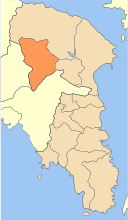Acharnes
| Acharnes Αχαρνές | |
|---|---|
 | |
 Acharnes | |
|
Location within the region  | |
| Coordinates: 38°5′N 23°44′E / 38.083°N 23.733°ECoordinates: 38°5′N 23°44′E / 38.083°N 23.733°E | |
| Country | Greece |
| Administrative region | Attica |
| Regional unit | East Attica |
| Government | |
| • Mayor | Sotiris Douros (Ind.) |
| Area | |
| • Municipality | 149.96 km2 (57.90 sq mi) |
| • Municipal unit | 146.41 km2 (56.53 sq mi) |
| Elevation | 186 m (610 ft) |
| Population (2011)[1] | |
| • Municipality | 106,943 |
| • Municipality density | 710/km2 (1,800/sq mi) |
| • Municipal unit | 100,743 |
| • Municipal unit density | 690/km2 (1,800/sq mi) |
| Time zone | EET (UTC+2) |
| • Summer (DST) | EEST (UTC+3) |
| Postal code | 136 xx |
| Area code(s) | 210 |
| Vehicle registration | Z |
| Website | www.acharnes.gr |
Acharnes (Greek: Αχαρνές, before 1915: Μενίδι Menidi[2]) is a suburban town in Attica, Greece. With 106,943 inhabitants (2011 census), it is the most populous municipality in East Attica. It is part of the Athens metropolitan area.
Geography
The northern part of the municipality is covered by the forested Parnitha mountains. The southern part is in the plain of Athens, and is densely populated. The built-up area of Acharnes, in this southern part of the municipality, is continuous with that of the adjacent suburbs to the west, east and south. The centre of Acharnes is 11 kilometres (7 miles) due north of Athens city centre. The two other settlements in the municipality, Thrakomakedones and Varympompi, are situated further north, in the foothills of Parnitha.
Acharnes is crossed by several important roads and railways, including Motorway 6, the Piraeus–Platy railway and the Athens Airport–Kiato railway. The Acharnes Railway Center is the main railway junction of Attica.
Acharnes is home to the Folk Art Museum of Acharnes.
History
Acharnes was named after the deme Acharnae (Ancient Greek: Ἁχαρναί), a subdivision of Attica in classical antiquity. The Athenian playwright Aristophanes characterised the inhabitants of Acharnae as peasants in his play The Acharnians. Acharnes suffered significant damage from the 1999 Athens earthquake, being very close to the epicenter.
Municipality
The municipality Acharnes was formed at the 2011 local government reform by the merger of the following 2 former municipalities, that became municipal units:[3]
- Acharnes
- Thrakomakedones
The municipality has an area of 149.956 km2, the municipal unit 146.406 km2.[4]
Historical population
| Year | Municipal unit | Municipality |
|---|---|---|
| 1981 | 41,068 | - |
| 1991 | 61,352 | - |
| 2001 | 75,341 | - |
| 2011 | 100,743 | 106,943 |
Museums
The Folk Art Museum of Acharnes is a museum in Acharnes, a northern suburb of Athens, Greece. It was founded in 1977 by the local Greek Mountaineering Society, which also formed the Historical and Folklore Association in 1981, to which it bequeathed the museum in 1982. The archaeological part of the collection was then separated from the historical and folklore material and was given to the Hellenic Ministry of Culture. Former Minister Melina Mercouri founded for it the Archaeological Museum of Acharnes in a neoclassical building in the central square of Acharnes, which had formerly housed the local City Hall. The same building houses the Historical and Folklore Society and its Folk Art Museum to the present time.[5][6][7][8]
Sporting teams
- Acharnaikos F.C. - second division
See also
References
- ↑ "Απογραφή Πληθυσμού - Κατοικιών 2011. ΜΟΝΙΜΟΣ Πληθυσμός" (in Greek). Hellenic Statistical Authority.
- ↑ Name changes of settlements in Greece
- ↑ Kallikratis law Greece Ministry of Interior (Greek)
- ↑ "Population & housing census 1991 (incl. area and average elevation)" (in Greek). National Statistical Service of Greece.
- ↑ "Folk Art Museum of Acharnes, Acharnes". zoohara.com. Retrieved 20 March 2014.
- ↑ "Folk Art Museum of Acharnes". kitgan.com. Retrieved 20 March 2014.
- ↑ "info | Folk Art Museum of Acharnes". shelf3d.com. Retrieved 20 March 2014.
- ↑ "Acharnes Folk Art Museum". touristlink.com. Retrieved 20 March 2014.
External links
- Municipality of Acharnes (in Greek) Η Ι.Λ.Ε.Α. ιδρύθηκε το έτος 1981, με πρωτοβουλία τον Ελληνικού Ορειβατικού Συλλόγου Αχαρνών. Ήδη από το 1977, ο Ορειβατικός Σύλλογος, είχε ιδρύσει και οργανώσει, Λαογραφικό Μουσείο, το οποίο παράδωσε στην Ι.Λ.Ε.Α., μετά την ίδρυσή της, το 1982... Transl. The Historical and Folklore Society of Acharnes (ILEA) was founded in 1981, by the Greek Mountaineering Association of Acharnes. Already, since 1977 the Association had founded and organized a Folklore Museum, which it ceded to ILEA. // Το πρώτο Δ..Σ. της Ι.Λ.Ε.Α.... χώρισε το αρχαιολογικό από το ιστορικό - λαογραφικό υλικό, παρέδωσε το αρχαιολογικό υλικό στο Υπουργείο Πολιτισμού, με τον όρο να ιδρύσει αρχαιολογικό Μουσείο. Η τότε Υπουργός Πολιτισμού, Μελίνα Μερκούρη απεδέχθη τους όρους... Από τότε, έως σήμερα, η Ι.Λ.Ε.Α. και το αρχαιολογικό Μουσείο Αχαρνών, συστεγάζονται σε νεοκλασικό κτίριο... Transl. The first administration of ILEA... separated the archaeological from the historic-folklore material and ceded the archaeologiocal to the Ministry of Culture under the terms that an archaeological museum would be founded. The then Minister of Culture, Melina Merkouri accepted the terms... From then till today the ILEA and the Archaeolocical Museum of Acharnes are co-housed in a neoclassical building...
- City of Athens On the Archaeological Museum of Acharnes
- East Attica Prefecture (in Greek) This site has both museums in one naming, i.e. Folklore and Archaeological Museum of Acharnes (Λαογραφικό & Αρχαιολογικό Μουσείο Αχαρνών)
 |
Fyli | Avlonas | Malakasa, Afidnes |  |
| Ano Liosia | |
Agios Stefanos, Kryoneri | ||
| ||||
| | ||||
| Zefyri, Kamatero | Nea Filadelfeia, Metamorfosi | Nea Erythraia, Kifisia |
